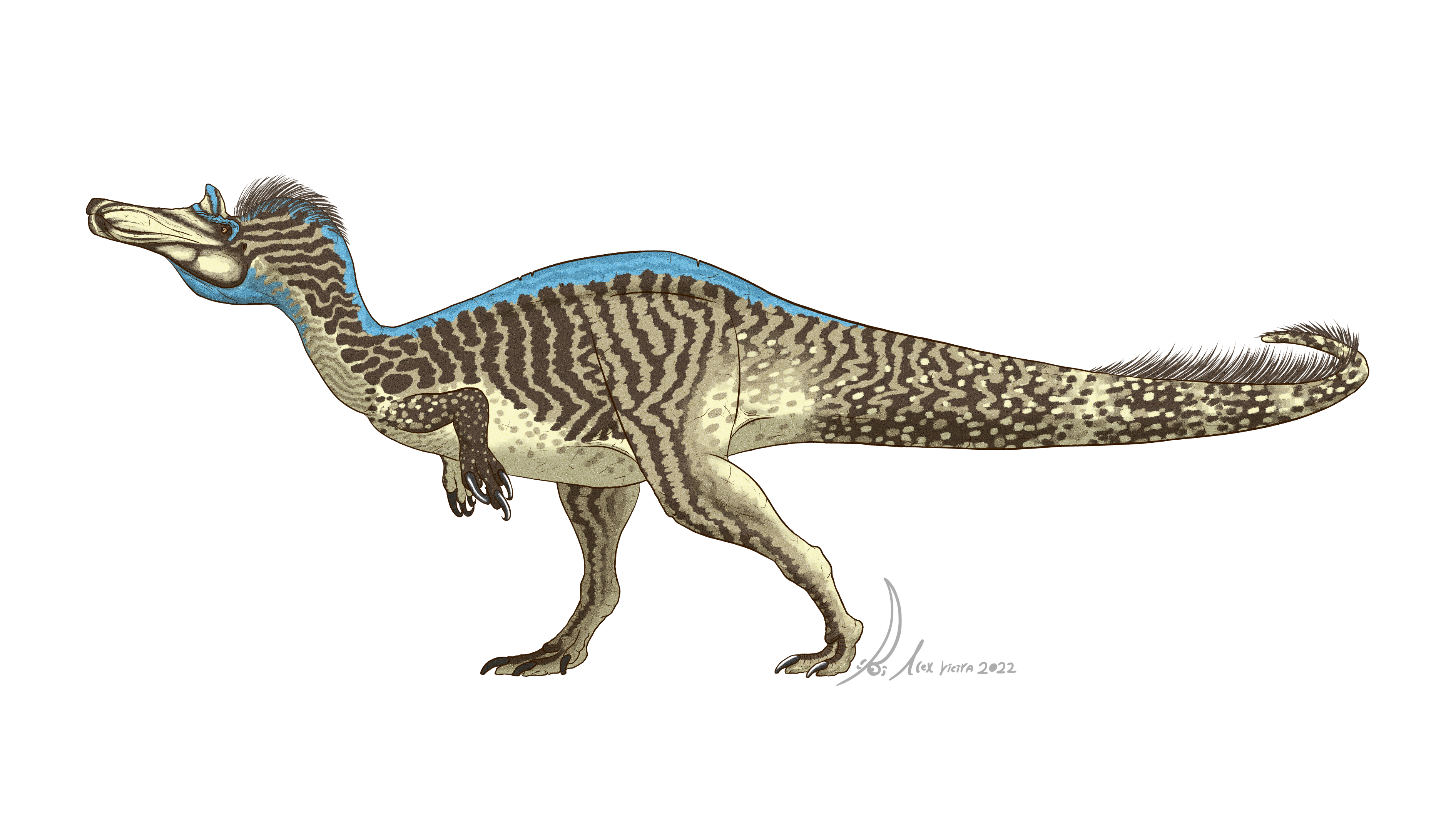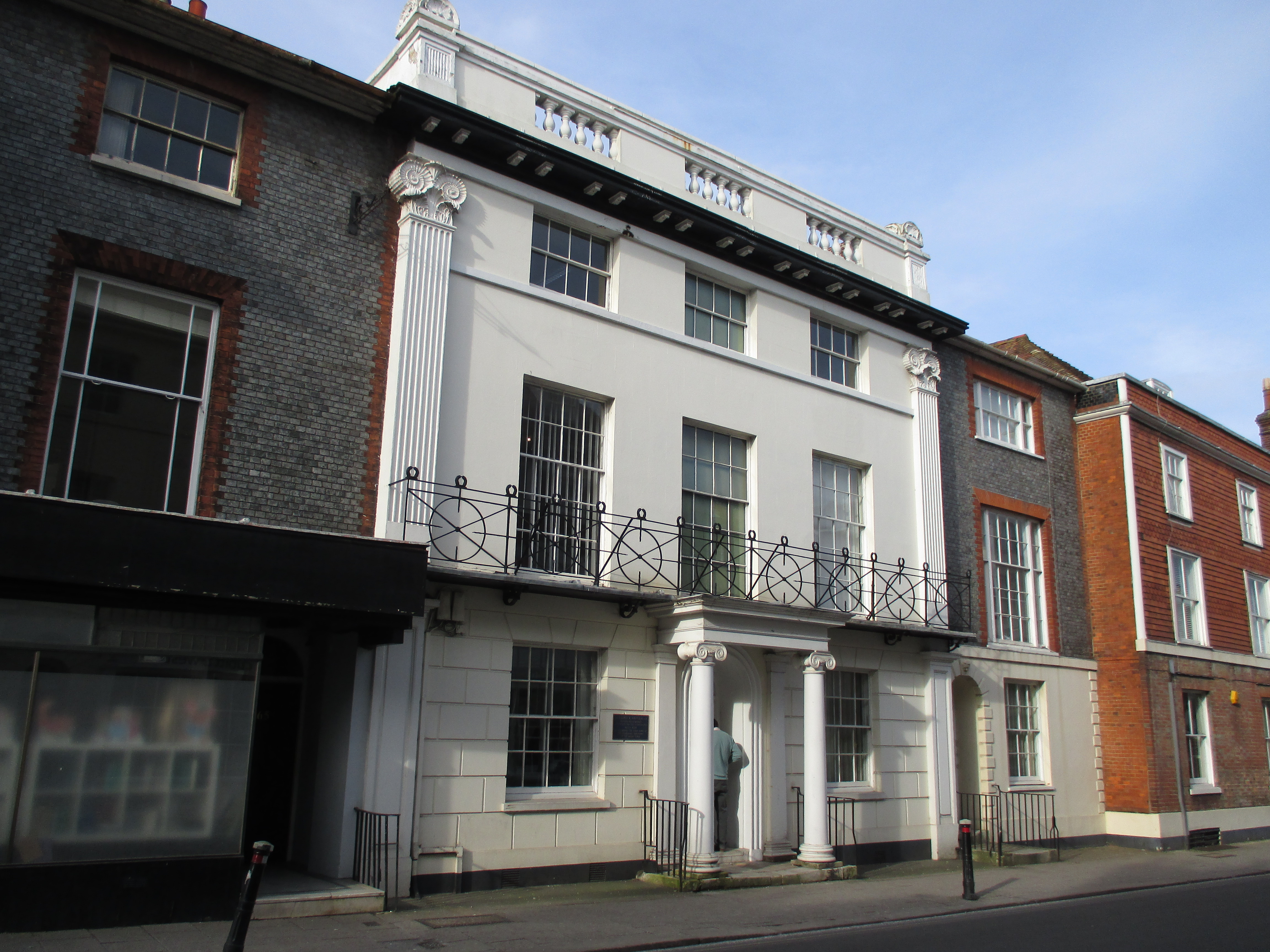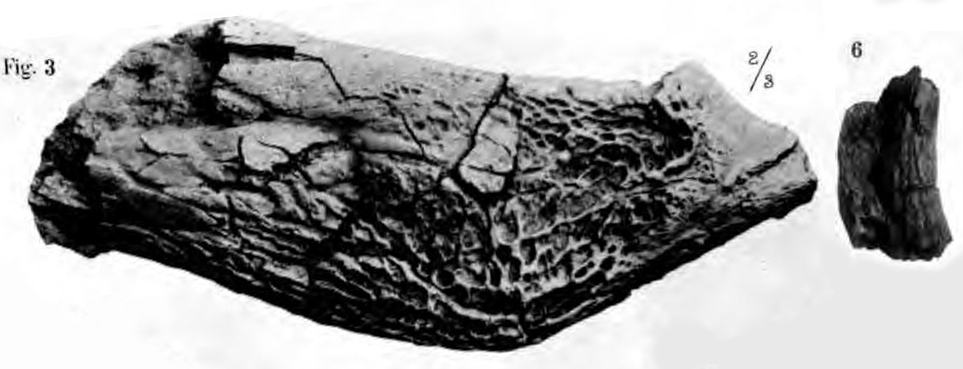|
Ceratosuchopsini
Baryonychinae is an extinct clade or subfamily of spinosaurids from the Early Cretaceous (Valanginian-Albian) of Britain, Portugal, and Niger. In 2021, it consisted of six genera: ''Ceratosuchops'', ''Cristatusaurus'', '' Riparovenator'', '' Suchomimus'', '' Suchosaurus'', and ''Baryonyx'', the nominal genus. The clade was named by Charig & Milner in 1986 and defined by Sereno ''et al''. in 1998 and Holtz ''et al.'' in 2004 as all taxa more closely related to '' Baryonyx walkeri'' than to ''Spinosaurus aegyptiacus''. Baryonychines were large, bipedal predators with elongated, crocodile-like skulls and lower jaw tips fanning out into rosettes bearing conical, often unserrated, teeth, and a distinct premaxillary notch. They possessed robust forelimbs supporting three-fingered hands with an enlarged first digit claw, to which the subfamily name indirectly refers. Members of this group, unlike the more derived Spinosaurinae, sported only low sails or none at all. History of di ... [...More Info...] [...Related Items...] OR: [Wikipedia] [Google] [Baidu] |
Ceratosuchops
''Ceratosuchops'' (meaning "horned crocodile face") is a genus of spinosaurid from the Early Cretaceous (Barremian) of Britain. Discovery and naming In 2021, the type species ''C. inferodios'' was named and described by a team of paleontologists including Chris Barker, Darren Naish, David Hone and others. The specific name means "hell heron", in reference to the ecology presumed by the research team. The holotype remains of this taxon consist of IWCMS 2014.95.5 (premaxillary bodies), IWCMS 2021.30 (a posterior premaxilla fragment) and IWCMS 2014.95.1-3 (a nearly complete braincase), all of which were recovered from rocks in Chilton Chine of the Wessex Formation and stored at Dinosaur Isle museum. Referred remains include a single right postorbital (IWCMS 2014.95.4). Description ''Ceratosuchops'' is estimated to measure 8.5 m (27 ft) in length based on the skeletal reconstruction in the describing paper by Dan Folkes, 2021. Phylogeny The authors recovered ''Cerato ... [...More Info...] [...Related Items...] OR: [Wikipedia] [Google] [Baidu] |
Spinosaurid
The Spinosauridae (or spinosaurids) are a clade or family of tetanuran theropod dinosaurs comprising ten to seventeen known genera. They came into prominence during the Cretaceous period. Spinosaurid fossils have been recovered worldwide, including Africa, Europe, South America and Asia. Their remains have generally been attributed to the Early to Mid Cretaceous. Spinosaurids were large bipedal carnivores. Their crocodilian-like skulls were long, low and narrow, bearing conical teeth with reduced or absent serrations. The tips of their upper and lower jaws fanned out into a spoon-shaped structure similar to a rosette, behind which there was a notch in the upper jaw that the expanded tip of the lower jaw fit into. The nostrils of spinosaurids were retracted to a position further back on the head than in most other theropods, and they had bony crests on their heads along the midline of their skulls. Their robust shoulders wielded stocky forelimbs, with three-fingered hands that ... [...More Info...] [...Related Items...] OR: [Wikipedia] [Google] [Baidu] |
Spinosaurinae
The Spinosauridae (or spinosaurids) are a clade or family of tetanuran theropod dinosaurs comprising ten to seventeen known genera. They came into prominence during the Cretaceous period. Spinosaurid fossils have been recovered worldwide, including Africa, Europe, South America and Asia. Their remains have generally been attributed to the Early to Mid Cretaceous. Spinosaurids were large bipedal carnivores. Their crocodilian-like skulls were long, low and narrow, bearing conical teeth with reduced or absent serrations. The tips of their upper and lower jaws fanned out into a spoon-shaped structure similar to a rosette, behind which there was a notch in the upper jaw that the expanded tip of the lower jaw fit into. The nostrils of spinosaurids were retracted to a position further back on the head than in most other theropods, and they had bony crests on their heads along the midline of their skulls. Their robust shoulders wielded stocky forelimbs, with three-fingered hands that ... [...More Info...] [...Related Items...] OR: [Wikipedia] [Google] [Baidu] |
Riparovenator
''Riparovenator'' ("riverbank hunter") is a genus of baryonychine spinosaurid dinosaur from the Early Cretaceous (Barremian) period of Britain, the type species is ''Riparovenator milnerae''. Discovery and naming Between 2013 and 2017, spinosaurid fossils were uncovered at the beach near the Chilton Chine before being brought to Dinosaur Isle. Such remains had been generally referred to ''Baryonyx'' but were understood recently to represent two species new to science. In 2021, the type species ''Riparovenator milnerae'' was named and described by a team of palaeontologists including Chris T. Barker, David William Elliot Hone, Darren Naish, Andrea Cau, Jeremy A.F. Lockwood, Brian Foster, Claire E. Clarkin, Philipp Schneider and Neil John Gostling. The generic name is derived from the Latin ''rīpārius'', "of the river bank", and ''vēnātor'', "hunter". The specific name honors Angela Milner, deceased in August 2021. The holotype remains of this taxon consist of IWCMS ... [...More Info...] [...Related Items...] OR: [Wikipedia] [Google] [Baidu] |
Suchomimus
''Suchomimus'' (meaning "crocodile mimic") is a genus of spinosaurid dinosaur that lived between 125 and 112 million years ago in what is now Niger, during the Aptian to early Albian stages of the Early Cretaceous period. It was named and described by palaeontologist Paul Sereno and colleagues in 1998, based on a partial skeleton from the Elrhaz Formation. ''Suchomimus'''s long and shallow skull, similar to that of a crocodile, earns it its generic name, while the specific name ''Suchomimus tenerensis'' alludes to the locality of its first remains, the Ténéré Desert. ''Suchomimus'' was a relatively large theropod, reaching in length and weighing . However, the age of the holotype specimen is uncertain, so it is unclear whether this size estimate would have been its maximum. The narrow skull of ''Suchomimus'' was perched on a short neck, and its forelimbs were powerfully built, bearing a giant claw on each thumb. Along the midline of the animal's back ran a low dorsal ... [...More Info...] [...Related Items...] OR: [Wikipedia] [Google] [Baidu] |
Baryonyx
''Baryonyx'' () is a genus of theropod dinosaur which lived in the Barremian stage of the Early Cretaceous period, about 130–125 million years ago. The first skeleton was discovered in 1983 in the Smokejack Clay Pit, of Surrey, England, in sediments of the Weald Clay Formation, and became the holotype specimen of ''Baryonyx walkeri'', named by palaeontologists Alan J. Charig and Angela C. Milner in 1986. The generic name, ''Baryonyx'', means "heavy claw" and alludes to the animal's very large claw on the first finger; the specific name, ''walkeri'', refers to its discoverer, amateur fossil collector William J. Walker. The holotype specimen is one of the most complete theropod skeletons from the UK (and remains the most complete Spinosaurid), and its discovery attracted media attention. Specimens later discovered in other parts of the United Kingdom and Iberia have also been assigned to the genus, though many have since been moved to new genera. The holotype specimen, whic ... [...More Info...] [...Related Items...] OR: [Wikipedia] [Google] [Baidu] |
Baryonyx Walkeri
''Baryonyx'' () is a genus of theropod dinosaur which lived in the Barremian Geological stage, stage of the Early Cretaceous Period (geology), period, about 130–125 million years ago. The first skeleton was discovered in 1983 in the Smokejack Clay Pit, of Surrey, England, in sediments of the Weald Clay Formation, and became the holotype specimen of ''Baryonyx walkeri'', named by palaeontologists Alan J. Charig and Angela C. Milner in 1986 in paleontology, 1986. The generic name, ''Baryonyx'', means "heavy claw" and alludes to the animal's very large claw on the first finger; the Specific name (zoology), specific name, ''walkeri'', refers to its discoverer, amateur fossil collector William J. Walker. The holotype specimen is one of the most complete theropod skeletons from the UK (and remains the most complete Spinosauridae, Spinosaurid), and its discovery attracted media attention. Specimens later discovered in other parts of the United Kingdom and Iberia have also been assigned ... [...More Info...] [...Related Items...] OR: [Wikipedia] [Google] [Baidu] |
First Digit
Significant figures (also known as the significant digits, ''precision'' or ''resolution'') of a number in positional notation are digits in the number that are reliable and necessary to indicate the quantity of something. If a number expressing the result of a measurement (e.g., length, pressure, volume, or mass) has more digits than the number of digits allowed by the measurement resolution, then only as many digits as allowed by the measurement resolution are reliable, and so only these can be significant figures. For example, if a length measurement gives 114.8 mm while the smallest interval between marks on the ruler used in the measurement is 1 mm, then the first three digits (1, 1, and 4, showing 114 mm) are certain and so they are significant figures. Digits which are uncertain but ''reliable'' are also considered significant figures. In this example, the last digit (8, which adds 0.8 mm) is also considered a significant figure even though ther ... [...More Info...] [...Related Items...] OR: [Wikipedia] [Google] [Baidu] |
Gideon Mantell
Gideon Algernon Mantell MRCS FRS (3 February 1790 – 10 November 1852) was a British obstetrician, geologist and palaeontologist. His attempts to reconstruct the structure and life of ''Iguanodon'' began the scientific study of dinosaurs: in 1822 he was responsible for the discovery (and the eventual identification) of the first fossil teeth, and later much of the skeleton, of ''Iguanodon''. Mantell's work on the Cretaceous of southern England was also important. Early life and medical career Mantell was born in Lewes, Sussex as the fifth-born child of Thomas Mantell, a shoemaker, and Sarah Austen. He was raised in a small cottage in St. Mary's Lane with his two sisters and four brothers. As a youth, he showed a particular interest in the field of geology. He explored pits and quarries in the surrounding areas, discovering ammonites, shells of sea urchins, fish bones, coral, and worn-out remains of dead animals. The Mantell children could not study at local grammar schools ... [...More Info...] [...Related Items...] OR: [Wikipedia] [Google] [Baidu] |
Wadhurst Clay Formation
The Wadhurst Clay Formation is a geological unit which forms part of the Wealden Group and the middle part of the now unofficial Hastings Beds. These geological units make up the core of the geology of the High Weald in the English counties of West Sussex, East Sussex and Kent. The other component formations of the Hastings Beds are the underlying Ashdown Formation and the overlying Tunbridge Wells Sand Formation. The Hastings Beds in turn form part of the Wealden Group which underlies much of southeast England. The sediments of the Weald, including the Wadhurst Clay Formation, were deposited during the Early Cretaceous Period, which lasted for approximately 40 million years from 140 to 100 million years ago. The Wadhurst Clay is of Early to Late Valanginian age.Hopson, P.M., Wilkinson, I.P. and Woods, M.A. (2010) ''A stratigraphical framework for the Lower Cretaceous of England''. Research Report RR/08/03. British Geological Survey, Keyworth. The Formation takes its name from th ... [...More Info...] [...Related Items...] OR: [Wikipedia] [Google] [Baidu] |
Early Cretaceous
The Early Cretaceous ( geochronological name) or the Lower Cretaceous (chronostratigraphic name), is the earlier or lower of the two major divisions of the Cretaceous. It is usually considered to stretch from 145 Ma to 100.5 Ma. Geology Proposals for the exact age of the Barremian-Aptian boundary ranged from 126 to 117 Ma until recently (as of 2019), but based on drillholes in Svalbard the defining early Aptian Oceanic Anoxic Event 1a (OAE1a) was carbon isotope dated to 123.1±0.3 Ma, limiting the possible range for the boundary to c. 122–121 Ma. There is a possible link between this anoxic event and a series of Early Cretaceous large igneous provinces (LIP). The Ontong Java-Manihiki-Hikurangi large igneous province, emplaced in the South Pacific at c. 120 Ma, is by far the largest LIP in Earth's history. The Ontong Java Plateau today covers an area of 1,860,000 km2. In the Indian Ocean another LIP began to form at c. 120 Ma, the Kerguelen P ... [...More Info...] [...Related Items...] OR: [Wikipedia] [Google] [Baidu] |
Suchosaurus Cultridens
''Suchosaurus'' (meaning "crocodile lizard") is a spinosaurid dinosaur from Cretaceous England and Portugal, originally believed to be a genus of crocodile. The type material, consisting of teeth, was used by British palaeontologist Richard Owen to name the species ''S. cultridens'' in 1841. Later in 1897, French palaeontologist Henri-Émile Sauvage named a second species, ''S. girardi'', based on two fragments from the mandible and one tooth discovered in Portugal. ''Suchosaurus'' is possibly a senior synonym of the contemporary spinosaurid ''Baryonyx'', but is usually considered a dubious name due to the paucity of its remains, and is considered an indeterminate baryonychine. In the Wadhurst Clay Formation of what is now southern England, ''Suchosaurus'' lived alongside other dinosaurs, as well as plesiosaurs, mammals, and crocodyliforms. History of discovery In about 1820, British palaeontologist Gideon Mantell acquired teeth discovered near Cuckfield in the Wadhurst Clay of ... [...More Info...] [...Related Items...] OR: [Wikipedia] [Google] [Baidu] |







